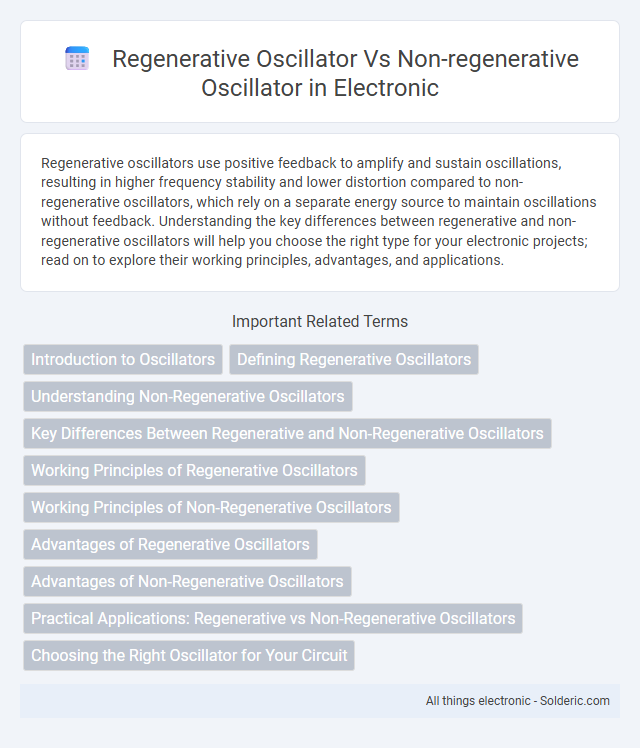Regenerative oscillators use positive feedback to amplify and sustain oscillations, resulting in higher frequency stability and lower distortion compared to non-regenerative oscillators, which rely on a separate energy source to maintain oscillations without feedback. Understanding the key differences between regenerative and non-regenerative oscillators will help you choose the right type for your electronic projects; read on to explore their working principles, advantages, and applications.
Comparison Table
| Feature | Regenerative Oscillator | Non-Regenerative Oscillator |
|---|---|---|
| Feedback Type | Positive feedback with controlled regeneration | Positive feedback without controlled regeneration |
| Oscillation Mechanism | Uses regenerative feedback to amplify signal | Relies on fixed gain and phase shift |
| Frequency Stability | Moderate stability, affected by feedback tuning | Higher stability with stable components |
| Output Waveform | Generally sine or other periodic signals | Typically sine wave, stable amplitude |
| Complexity | More complex due to feedback control | Relatively simple design |
| Common Applications | Signal generation, frequency synthesis | Radio transmitters, clocks |
| Energy Efficiency | Higher due to feedback amplification | Lower, relies on constant gain |
Introduction to Oscillators
Regenerative oscillators use positive feedback to sustain oscillations by amplifying a portion of the output signal back to the input, enabling continuous waveform generation. Non-regenerative oscillators rely on the inherent frequency-determining components like RC or LC networks without feedback amplification, producing oscillations based on the circuit's natural resonance. Key examples include the Armstrong oscillator, a regenerative type, and the Wien bridge oscillator, a non-regenerative type, each suited for different signal stability and frequency control applications.
Defining Regenerative Oscillators
Regenerative oscillators utilize positive feedback to sustain oscillations by amplifying the signal within the circuit, enabling continuous waveform generation without an external input. In contrast, non-regenerative oscillators rely on a combination of active and passive components to produce oscillations through natural resonance without signal reinforcement. Understanding the regenerative principle helps you choose the appropriate oscillator type for applications requiring signal stability and amplification.
Understanding Non-Regenerative Oscillators
Non-regenerative oscillators rely on positive feedback through an amplifier, which sustains oscillations without regeneration or storage of energy. These oscillators typically use a single feedback path and are simpler but less stable compared to regenerative oscillators, which incorporate feedback loops that amplify the signal repeatedly to maintain oscillations. Non-regenerative oscillators are commonly deployed in applications requiring steady frequency generation with minimal complexity, such as in basic timing circuits.
Key Differences Between Regenerative and Non-Regenerative Oscillators
Regenerative oscillators utilize positive feedback to sustain oscillations by amplifying signals, resulting in higher frequency stability and amplitude compared to non-regenerative oscillators, which rely on external energy or periodic input to maintain oscillations. Non-regenerative oscillators typically exhibit lower efficiency and reduced waveform purity due to the absence of continuous feedback, causing more signal distortion and amplitude variation. The key distinction lies in the feedback mechanism, where regenerative oscillators achieve self-sustained oscillations through internal feedback loops, whereas non-regenerative oscillators function only with external triggering or energy input.
Working Principles of Regenerative Oscillators
Regenerative oscillators operate by feeding a portion of the output signal back into the input through positive feedback, amplifying the signal until sustained oscillations occur. This positive feedback loop increases the overall gain, compensating for any energy losses and enabling continuous waveform generation at a specific frequency. Your circuit design benefits from the inherent high gain and frequency stability characteristic of regenerative oscillators.
Working Principles of Non-Regenerative Oscillators
Non-regenerative oscillators operate by using a single amplifier stage with positive feedback to sustain oscillations at a desired frequency without energy regeneration. The feedback network in these oscillators provides the necessary phase shift and amplitude to maintain steady-state oscillations but does not amplify the signal beyond the initial input. Common examples include simple RC or LC oscillators where the feedback is derived from voltage or current division, enabling the circuit to oscillate at a specific resonant frequency without complex regeneration mechanisms.
Advantages of Regenerative Oscillators
Regenerative oscillators offer superior frequency stability and reduced phase noise due to their positive feedback mechanism, which enhances signal amplification without requiring complex circuitry. They consume less power and generate higher output amplitude compared to non-regenerative oscillators, making them ideal for applications in radio frequency (RF) signal generation and frequency modulation. Their simple design results in lower manufacturing costs and improved reliability in communication systems.
Advantages of Non-Regenerative Oscillators
Non-regenerative oscillators offer simplicity in design and ease of frequency stability control compared to regenerative oscillators, making them ideal for applications requiring consistent oscillation without complex feedback mechanisms. Their reduced susceptibility to signal distortion and noise enhances the purity of the output waveform, which is critical in precision signal generation. Non-regenerative oscillators also provide faster start-up times and greater linearity, contributing to improved performance in communication and signal processing systems.
Practical Applications: Regenerative vs Non-Regenerative Oscillators
Regenerative oscillators excel in high-frequency applications like radio transmitters and signal amplification due to their ability to provide feedback that enhances signal strength and selectivity. Non-regenerative oscillators are preferred in stable, low-frequency contexts such as clocks and timing circuits, where consistency and low distortion are critical. Your choice between these oscillators depends on whether you require signal amplification and high-frequency operation or precise, stable oscillation without feedback.
Choosing the Right Oscillator for Your Circuit
Choosing the right oscillator for your circuit depends on the desired signal stability and frequency range. Regenerative oscillators leverage positive feedback to produce high-frequency signals with improved signal purity and efficiency, making them ideal for radio frequency applications. Non-regenerative oscillators, also known as relaxational oscillators, offer simpler design and lower frequency output, suitable for timing and waveform generation in digital electronics.
regenerative oscillator vs non-regenerative oscillator Infographic

 solderic.com
solderic.com